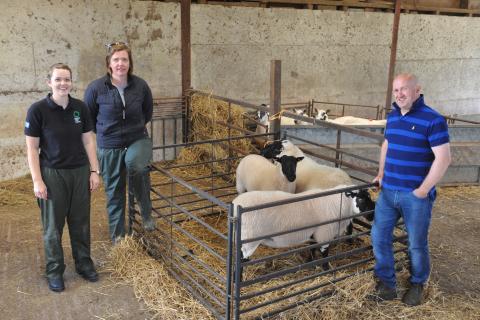28 August 2019
Getting ewes in the correct body condition score will increase scanning percentage, number of lambs born and the number of lambs weaned on Welsh sheep farms.
Autumn is a critical time for managing ewes for breeding but independent sheep specialist Dr Liz Genever says preparation must begin weeks earlier, shortly after weaning.
Ewe condition impacts on ovulation and conception rates because the level of body reserves influences the hormones needed for breeding.
Condition scoring at weaning therefore gives an important baseline for how ewes should be managed before the next breeding cycle because ewes that are too thin will have poor reproduction.
During a Farming Connect Knowledge Transfer event at Llwynrhydill, Upper Chapel, Dr Genever recommended separating ewes into three groups according to body condition – thin, fit and fat - with thin ewes given priority for grazing.
Running separate groups allows the quality and quantity of intakes to be controlled.
“There is a big chunk of time to gain body condition between weaning and tupping so it can be done,’’ said Dr Genever.
The aim should be to achieve the right fat level at mating in at least 90% of the flock – for lowland breeds that’s a condition score of 3.5 and in upland breeds 3.
The industry recommendation is 2.5 for hill breeds but Dr Genever believes a BCS of 3 might be desirable.
“The targets were developed in the 70s and I think they are a bit on the lean side, I think it is fine for hill ewes to carry a bit more condition,’’ she said.
“However, it could mean a higher scanning percentage and that needs to be managed.’’
Farmers should physically feel ewes for condition and not rely on a visual assessment. This can be done by handling them in the lumbar region, immediately behind the last rib. The amount of eye muscle and degree of fat cover over the spinous and transverse processes should be assessed.
It takes between 6-8 weeks to lift fat cover by one condition score so early intervention is key. One condition score is between 10-13% of body weight - that is 7-9kg in a 70kg ewe. “If you have a ewe at body condition score 2 and need to increase that to 3.5 it means she needs to put on 13kg,’’ Dr Genever calculated.
“That’s an additional 10 megajoules a day above maintenance requirements for 10 weeks which is almost the same as a pre-lambing diet.’’
Pre-tupping preparation should include a ram MOT 10 weeks before mating as getting tups to optimum health will influence scanning percentages.
“Rams need to be in good working order when the time comes to turn them in with the ewes so the planning needs to start a lot earlier than is common practice on some farms,’’ said Dr Genever.
It also means that, if problems are found, replacement rams can be purchased and quarantined.
Tups need to be in good body condition at mating but not fat as this can impact on fertility - Dr Genever recommends a BCS of 3.5- 4 at the start of tupping.
Farming Connect Red Meat Technical Officer Elan Davies said the principal message was that farmers must plan ahead.
“Don’t leave it until just before tupping, you have to allow sufficient time to get your rams in order and to get the condition on the ewes,’’ she said.
Lamb producer Kevin Parry plans for tupping as soon as his ewes have lambed.
“If you don’t get tupping right it impacts on everything you do afterwards, if you don’t get the lambs into the ewes at tupping you can’t do it afterwards,’’ he pointed out.
Mr Parry runs a flock of 500 Beulah Speckled Face and Welsh Mule ewes at Llwynrhydill, Upper Chapel, tupping with Texel, Beulah and Blue Faced Leicester rams.
To help manage labour requirements, he tups in three groups, the first from October 10th and the third from November 5th.
He aims to have Mule ewes at BCS 3.5 at breeding and Beulahs at 3-3.5. His vaccination and worming programme protects the health status of the flock.
Rams get similar treatment. “We keep a close eye on them, they are naturally fit off grass but we need them to be mobile,’’ said Mr Parry.
He single mates everything for the first cycle of 17 days.
“If it is a newly bought in ram we run him with no more than 20 ewes because we want to see how he performs, with proven rams we are happy with groups of 50 or more ewes,’’ said Mr Parry.
He sells his lambs to Kepak at 19-21kg deadweight. Ninety-five per cent achieve targets for carcase conformation and fat level.
Farming Connect, which is delivered by Menter a Busnes and Lantra, is funded by the European Agricultural Fund for Rural Development and Welsh Government.

